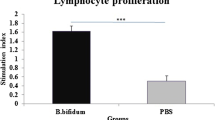Abstract
An efficacy test of PRP (polyribosylribitol phosphate)-TT (Tetanus toxoid) conjugate vaccines was carried out using BALB/c mice as an animal model by inoculatingHaemophilus influenzae type b (Hib) with a virulence enhancement factor (VEF). Three administrations of the conjugate vaccines at 2-week intervals elicited a significantly high level of PRP antibodies (P<0.0001). The protective activity of the PRP immunization was challenged with either Hib with iron dextran (Hibi) or with a combination of mucin and hemoglobin (Hibmh) as a VEF. The medium lethal dose (LD50) for Hibmh and Hibi was measured as 10 CFU (Colony Forming Unit) and 2.5×108 CFU respectively. Each immunized animal was challenged with five or ten times the LD50 level of bacteria with a VEF. A significant difference in mortality between the immunized and control mice (P<0.01) was observed with the Hibmh challenge inoculation but not with the Hibi challenge inoculation. These results show that a combination of mucin and hemoglobin was able to ehance the virulence of Hib in BALB/c mice to cause a lethal infection, thus suggesting that BALB/c mice introduced to this method can be an effective model animal for testing the protective efficacy ofH. influenzae conjugate vaccines.
Similar content being viewed by others
References
Cochi, S. L., C. V. Broome, and A. W. Hightower (1985) Immunization of US children withHaemophilus influenzae type b polysaccharide vaccine.J. Am. Med. Ass. 253: 521–529.
Coulehan, J. L., R. H. Michaels, K. E. Williams, D. K. Lemley, C. Q. Jr. North, T. K. Welty, and K. D. Rogers (1976) Bacterial meningitis in Navajo indians.Public Health Rep. 91: 464–468.
Tarr, P. I. and G. Peter (1978) Demographic factors in the epidemiology ofHaemophilus influenzae meningitis in young children.J. Pediat. 92: 884–888.
Ward, J. (1991) Prevention of invasiveHaemophilus influenzae type b disease: Lessons from vaccine efficacy trials.Vaccine 9: S17–24.
Pittman M. (1933) The action of type-specificH. influenzae antiserum.J. Exp. Med. 58: 683–706.
Onodera, M. (2002) Silicone rubber membrane bioreactors for bacterial cellulose production.Biotechnol. Bioprocess Eng. 10: 289–294.
Immunization practices advisory (ACIP) (1986) Update: Prevention ofHaemophilus influenzae type b disease.Morbid. Mortal. Week. Rep. 35: 170.
Heath, P. T. and M. Fracp (1998)Haemophilus influenzae type b conjugate vaccines: A review of efficacy data.Pediatr. Infect. Dis. J. 17: S117–122.
Burans, J. P., F. H. Kruszeski, M. Lynn, and M. Solotrovsky (1981) Kinetics ofHaemophilus influenzae type b infection in normal and ribosom-immunized mice using intraperitoneal and intracerebral routes of inoculation.Br. J. Exp. Pathol. 62: 496–503.
Kaplan, S. L., E. O. Mason Jr., and B. L. Wiedermann (1983) Role of adherence in the pathogenesis ofHaemophilus influenzae type b infection in infant rats.Infec. Immun. 42: 612–617.
Smith, A. L., D. H. Smith, D. R. Averill, Jr., J. Marino, and E. R. Moxon (1983)Haemophilus influenzae type b bacteremia and meningitis infant rabbits after intranasal inoculation.J. Lab. Clin. Med. 102: 939–946.
Moxon, E. R., A. L. Smith, D. R. Averill, and D. H. Smith (1974)Haemophilus influenzae meningitis in infant rats after intranasal inoculation.J. Infect. Dis. 129: 154–162.
Marks, M. I., E. J. Ziegler, H. Douglas, and L. B. Corbeil (1982) LethalHaemophilus influenzae type b infection in mice.Infection 10: 261–266.
Broueur, B. R., Y. Larose, P. Tsang, J. Hamel, F. Ashton, and A. Ryan (1983) Protection against infection withNeisseria meningitides group B serotype 2b by passive immunization with serotype specific monoclonal antibody.Infect. Immun. 50: 510–516.
Rodriguez, S. S., J. F. I. Bourzac, O. M. Chang, M. F. Medina, E. M. Carnago, and Y. L. Hernandez (1999) Virulence enhancement agents forHaemophilus influenzae type b infection in mice.Lab. Anim. Sci. 49: 95–98.
Halesy, N. A., T. L. Johansen, L. C. Bowman, and M. P. Glode (1983) Evaluation of the protective efficacy ofHaemophilus influenzae type b vaccines in an animal model.Infec. Immun. 39: 1196–1200.
Brodeur, B. R., P. S. Tsang, J. Hamel, Y. Larose, and S. Montplaisir (1986) Mouse models of infection forNeisseria meningitides B, 2b andHaemophilus influenzae type b diseases.Can. J. Microbiol. 32: 33–37.
Kristensen, K. and M. W. Bentzon (1992) Relation between enzyme-linked immunoserbent assay and radioimmunoassay for detection of antibodies to the capsular polysaccharide ofHaemophilus influenzae type b.APMIS 100: 142–146.
Farr, R. S. (1958) A quantitative immunochemical measurement of the primary interaction between I*BSA and antibody.J. Infect. Dis. 103: 239–262.
Kuo, J. S. C., N. Monji, R. S. Schwalbe, and D. W. McCoy (1981) A radioactive antigen-binding assay for the measurement of antibody toHaemophilus influenzae type b capsular polysaccharide.J. Immunol. Methods 43: 35–47.
Warlaw, A. C. (1985)Practical Statistics for Experimental Biologists. John Wiley & Sons Ltd, USA.
Corbeil, G. A., C. P. Kenny, and G. Laverne (1976) Iron as a replacement for much in the establishment of meningococcal infection in mice.Can. J. Microbiol. 22: 832–838.
Miller, C. P. (1933) Experimental meningococcal infection of mice.Science 78: 340–341.
Ward, J., G. Brenneman, G. W. Leston, and L. Heyward (1990) Limited efficacy of aHaemophilus influenzae type b conjugate vaccine in Alaska native infants.N. Engl. J. Med. 323: 1391–1401.
Hong, H. J. and S. T. Kim (2002) Antibody engineering.Biotechnol. Bioprocess Eng. 7: 150–154.
Frasch, C. E. (1994) Regulatory perspectives in vaccine licensure. pp. 435–453. In: Ellis R. W., D. W. Granoff (eds.).Development and Clinical Uses of Haemophilusb Conjugate Vaccine. Mercel Dekkar, New York, USA.
FDA approval of use of a newHaemophilus b conjugate vaccine and a combined diphtheria-tetanus-pertussis andHaemophilus b conjugate vaccine for infants and children. (1993)Morb. Mortal. Wkly. Rep. 42: 296–298.
Granoff, D. M. (2001) Assessing efficacy ofHaemophilus influenzae type b combination vaccines.Clin. Infect. Dis. 33: S278-S287.
Author information
Authors and Affiliations
Corresponding author
Rights and permissions
About this article
Cite this article
Kim, H.S., Yoo, T.H., Jang, Y.S. et al. An animal model to evaluate the protective efficacy ofHaemophilus influenzae type b conjugate vaccines. Biotechnol. Bioprocess Eng. 9, 490–494 (2004). https://doi.org/10.1007/BF02933491
Received:
Accepted:
Issue Date:
DOI: https://doi.org/10.1007/BF02933491




